Wounded Tigress Pictures from Tadoba on Social Media Caught the Eyes of Wildlife Lovers
 Last Updated: 22 Jul, 2019 By Nidhi Singh
Last Updated: 22 Jul, 2019 By Nidhi Singh

Disclaimer: Some images can be disturbing, but keeping authenticity and wildlife awareness in view, we have not blurred the original images.
On March 31, a set of pictures of a wounded tigress in Tadoba National Park in Maharashtra started to make rounds on social media. The disquieting pictures showed a tigress licking what seems to be a wire snare wound on her neck. The picture sent shockwaves amongst wildlife lover and experts. Let us get a detailed picture of what actually happened in this one of the major tiger reserves in India.
The Incident:
On March 30, 2019, three groups of tourists on their early morning jeep safari spotted Shivanzari tigress relaxing in a waterhole in Kolsa Range. The closer look made them observe a wound on the tigress neck, which the big cat was finding difficult to lick.
On March 31, the pictures clicked by one of the tourists, Suresh Wankhede started to get viral over social media and raised a ruckus among wildlife enthusiasts. Wankhede said, “I saw deep wound on the right side of the tigress’s neck. It was bleeding and the big cat was trying to lick the wound with her tongue with great difficulty. I don’t know nature of injury. It may be due to fight or received while making a kill.”
Who was the Tigress in the Pictures?

This big cat is considered the dominant tigress in Kolsa Range and she said to be around 10 years of age and has delivered at least 16 cubs through four litters.
What are the Experts and Authorities Suggesting?
When observed closely, the marks on the tigress neck suggest that she had entangled herself in wire snare meant to trap an herbivore for bushmeat by poachers. However, the authorities at Tadoba-Andhari Tiger Reserve (TATR) suggest otherwise; according to them, the reason of the wound can be a bear attack, as the camera traps showed the presence of bears in the area.
So What Are These Wire Snares?
According to Nitin Desai, Central India director of Wildlife Protection Society of India (WPSI), “These snares are made using GI wires or inners of motorcycle clutch wires. They can be as small as six inches in diameter to snare small mammals like a hare or big enough to trap a male sambar stag with antlers.”
Why Experts Are Certain About the Use of Wire Snare in Tadoba?

Tadoba National Park has a history of wire snares used by the poachers. According to Desai of WPSI, a large number of wire snares were seized from this national park in Maharashtra set up or hidden in and around Tadoba Forest. These snares are usually used by the poachers for trapping the bushmeat. In fact, in 2009, more than 200 wire snares were seized from Shivni, Wasera and Piparheti areas surrounding Kolsa.
In 2010, according to a retired forest official, poachers killed a tigress in Hirdinala in Kolsa using wire snare. Her claws were seized from the accused who belonged to Jamni and Kolsa.
In fact, recently in 2017, a Tipeshwar tigress was found with a wire snare around her neck. She died in March the next year, probably succumbing to her wound.
What is the Take of Wildlife Enthusiasts and Experts on Tiger Safety in Tadoba

According to a wildlife lover, Dr Banait, the national park’s field staff fails to report such matters as there is no foot patrolling. Dr Banait also showed concern on the park’s decision of increasing the capacity of tourist vehicles in Kolsa Range from 3 to 10. On the other hand, the Honorary wildlife warden Bandu Dhotre suggests that relocating Rantalodi and Kolsa villages from inside the park is the best solution to save tigers. Whereas, WPSI’s Nitin Desai points out that this recent incident shows that the practice of wire snares is still prevalent, and thus, strict action against it should be taken.
Photo Credit: Suresh Wankhede
 Published: 02 Apr, 2019By Nidhi Singh
Published: 02 Apr, 2019By Nidhi Singh
Popular Post
Category by Destinations
Travel Intel
Category by Continent
India recent post
Enquiry Form
Get Customized Travel Quotes from Tour My India








